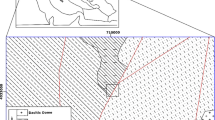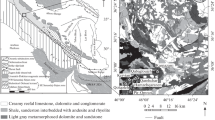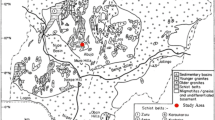Abstract
This paper describes the application of the knowledge-based fuzzy logic method to integrate various exploratory geo-dataset in order to prepare a mineral prospectivity map (MPM) for copper exploration. Different geophysical layers which are derived from the magnetic and the electrical surveys, along with the ones extracted from the background geology (i.e., lithology, fault and alteration) and geochemical data are incorporated in such process. Seridune copper deposit located in the Kerman province of Iran is the case study to delineate its high potential zones of Cu-bearing mineralization for drilling additional boreholes. Four layers from the magnetic data involving upward continuation, analytic signal, reduced to pole and pseudo gravity are assigned in the multi-disciplinary geo-dataset to locate the intrusive complexes responsible for Cu mineralization. The apparent resistivity, chargeability and sulfide factor layers acquired from geo-electrical data are also included in the final preparation of MPM. Then the normalized weights of seven geophysical, three geological and one geochemical evidential layers as main criteria are determined based upon the knowledge of expert decision makers. Fuzzy operators (i.e., Sum and Gamma) are applied to integrate these exploratory features. To evaluate the performance and applicability of the approach, the productivity of the drilled boreholes (Cu concentration multiplied by ore thickness) are used to validate the produced MPMs. It is shown that an optimum correlation coefficient of 0.86 exists between the MPM values and Cu productivity criterion along drilled boreholes.











Similar content being viewed by others
References
Abedi M, Norouzi GH (2012) Integration of various geophysical data with geological and geochemical data to determine additional drilling for copper exploration. J Appl Geophys 83:35–45
Abedi M, Norouzi GH, Bahroudi A (2012a) Support vector machine for multi-classification of mineral prospectivity areas. Comput Geosci 46:272–283
Abedi M, Torabi SA, Norouzi GH, Hamzeh M, Elyasi GR (2012b) PROMETHEE II: a knowledge-driven method for copper exploration. Comput Geosci 46:255–263
Abedi M, Torabi SA, Norouzi GH, Hamzeh M (2012c) ELECTRE III: a knowledge-driven method for integration of geophysical data with geological and geochemical data in mineral prospectivity mapping. J Appl Geophys 87:9–18
Abedi M, Norouzi GH, Torabi SA (2013a) Clustering of mineral prospectivity area as an unsupervised classification approach to explore copper deposit. Arab J Geosci 6:3601–3613
Abedi M, Torabi SA, Norouzi GH (2013b) Application of fuzzy-AHP method to integrate geophysical data in a prospect scale, a case study: seridune copper deposit. Boll Geofis Teor Appl 54:145–164
Abedi M, Norouzi GH, Fathianpour N (2013c) Fuzzy outranking approach: a knowledge-driven method for mineral prospectivity mapping. Int J Appl Earth Obs Geoinf 21:556–567
Abedi M, Gholami A, Norouzi GH, Fathianpour N (2013d) Fast inversion of magnetic data using lanczos bidiagonalization method. J Appl Geophys 90:126–137
Abedi M, Norouzi GH, Fathianpour N (2015) Fuzzy ordered weighted averaging method: a knowledge-driven approach for mineral potential mapping. Geophys Prospect 63:461–477
Agterberg FP, Bonham-Carter GF (1999) Logistic regression and weights of evidence modeling in mineral exploration. Proceedings of the 28th International Symposium on Applications of Computer in the Mineral Industry (APCOM), Golden, pp 483–490
Agterberg FP, Bonham-Carter GF, Wright DF (1990) Statistical pattern integration for mineral exploration. In: Gaál G, Merriam DF (eds) Computer applications in resource estimation. Pergamon Press, Oxford, pp. 1–21
Alavi M (1980) Tectonostratigraphic evolution of the zagrosides of Iran. Geology 8:144–149
Ansari AH, Alamdar K (2009) Reduction to the pole of magnetic anomalies using analytic signal. World Applied Sciences Journal 7:405–409
Barzegar H (2007) Geology, petrology and geochemical characteristics of alteration zones within the Seridune prospect, Kerman, Iran. PhD Thesis, RWTH Aachen University, Germany, p 180
Berberian F, Muir ID, Pankhurst RJ, Berberian M (1982) Late cretaceous and early Miocene Andean-type plutonic activity in northern makran and central Iran. J Geol Soc Lond 139:605–614
Blakely RJ (1995) Potential theory in gravity and magnetic applications. Cambridge Univ. Press
Bonham-Carter GF, Agterberg FP, Wright DF (1989) Weights-of-evidence modelling: a new approach to mapping mineral potential. In: Agterberg FP, Bonham-Carter GF (eds) Statistical Applications in the Earth Sciences. Paper, 89–9. Geological Survey of Canada, pp 171–183
Carranza EJM (2008) Geochemical anomaly and mineral prospectivity mapping in GIS. Handbook of Exploration and Environmental Geochemistry, vol. 11. Elsevier, Amsterdam, p 351
Carranza EJM, Hale M (2001) Logistic regression for geologically constrained mapping of gold potential, Baguio district, Philippines. Explor Min Geol 10:165–175
Carranza EJM, Hale M (2002a) Spatial association of mineral occurrences and curvilinear geological features. Math Geol 34:203–221
Carranza EJM, Hale M (2002b) Where porphyry copper deposits are spatially localized? A case study in Benguet province, Philippines. Nat Resour Res 11:45–59
Carranza EJM, Hale M (2002c) Evidential belief functions for data-driven geologically constrained mapping of gold potential, Baguio district, Philippines. Ore Geol Rev 22:117–132
Carranza EJM, Hale M (2002d) Wildcat mapping of gold potential, Baguio district, Philippines. Transactions Institute of Mining and Metallurgy (Applied Earth Science) 111:100–105
Carranza EJM, Hale M (2003) Evidential belief functions for data-driven geologically constrained mapping of gold potential, Baguio district, Philippines. Ore Geol Rev 22:117–132
Carranza EJM, Laborte AG (2015) Random forest predictive modeling of mineral prospectivity with small number of prospects and data with missing values in Abra (Philippines). Comput Geosci 74:60–70
Carranza EJM, Mangaoang JC, Hale M (1999) Application of mineral exploration models and GIS to generate mineral potential maps as input for optimum land-use planning in the Philippines. Nat Resour Res 8:165–173
Carranza EJM, Woldai T, Chikambwe EM (2005) Application of data-driven evidential belief functions to prospectivity mapping for aquamarine-bearing pegmatites, lundazi district, Zambia. Nat Resour Res 14:47–63
Carranza EJM, Wibowo H, Barritt SD, Sumintadireja P (2008a) Spatial data analysis and integration for regional-scale geothermal potential mapping, west java, Indonesia. Geothermics 33:267–299
Carranza EJM, van Ruitenbeek FJA, Hecker CA, van der Meijde M, van der Meer FD (2008b) Knowledge-guided data-driven evidential belief modeling of mineral prospectivity in Cabo de gata, SE Spain. Int J Appl Earth Obs Geoinf 10:374–387
Clark DA (1999) Magnetic petrology of igneous intrusions-implications for exploration and magnetic interpretation. Explor Geophys 20:5–26
Clark DA (2014) Magnetic effects of hydrothermal alteration in porphyry copper and iron-oxide copper–gold systems: a review. Tectonophysics 624–625:46–65
Harris DP, Zurcher L, Stanley M, Marlow J, Pan G (2003) A comparative analysis of favourability mappings by weights of evidence, probabilistic neural networks, discriminant analysis, and logistic regression. Nat Resour Res 12:241–255
Hernández Pardo O, Alexander GC, Pintor IM (2012) Geophysical exploration of disseminated and stockwork deposits associated with plutonic intrusive rock: a case study on the eastern flank of Colombia’s western cordillera. Earth Sci Res J 16:11–23
Hossaini SA, Abedi M (2015) Data envelopment analysis: a knowledge-driven method for mineral prospectivity mapping. Comput Geosci 82:111–119
John DA, Ayuso RA, Barton MD, Blakely RJ, Bodnar RJ, Dilles JH, Gray Floyd, Graybeal FT, Mars JC, McPhee DK, Seal RR, Taylor RD, Vikre PG (2010) Porphyry copper deposit model, chap. B of Mineral deposit models for resource assessment: U.S. Geological Survey Scientific Investigations Report 2010–5070–B, p 169
Kazemi Mehrnia A, Rasa I, Alirezaei S, Asadi Harooni H, Karami J (2011) Alteration mapping at saridoon porphyry copper prospect using short wave infrared spectrometry (PIMA), ASTER satellite image and XRD. Geoscience Scientific Quarterly Journal 79:3–12
Mejía-Herrera P, Royer JJ, Caumon G, Cheilletz A (2014) Curvature attribute from surface-restoration as predictor variable in Kupferschiefer copper potentials: an example from the Fore-Sudetic Region. Natural Resources Research, http://dx.doi.org/10.1007/s11053-014-9247-7
Mirzaei M, Afzal P, Adib A, Khalajmasoumi M, Zarifi AZ (2014) Prospection of iron and manganese using index overlay. and fuzzy logic methods in balvard 1:100,000 sheet, southeastern Iran. Iranian Journal of Earth Sciences 6:1–11
Moon WM (1990) Integration of geophysical and geological data using evidential belief function. IEEE Trans Geosci Remote Sens 28:711–720
Moradi M, Basiri S, Kananian A, Kabiri K (2015) Fuzzy logic modeling for hydrothermal gold mineralization mapping using geochemical, geological, ASTER imageries and other geo-data, a case study in central Alborz, Iran. Earth Sci Inf 8:197–205
Nabighian MN (1972) The analytic signal of two-dimensional magnetic bodies with polygonal cross-section: its properties and use for automated anomaly interpretation. Geophysics 37(3):507–517
Nabighian MN (1974) Additional comments on the analytic signal of two dimensional magnetic bodies with polygonal cross-section. Geophysics 39:85–92
Nabighian MN (1984) Toward a three-dimensional automatic interpretation of potential field data via generalized Hilbert transforms: fundamental relations. Geophysics 49:780–786
Najafi A, Karimpour MH, Ghaderi M (2014) Application of fuzzy AHP method to IOCG prospectivity mapping: A case study in Taherabad prospecting area, eastern Iran. Int J Appl Earth Obs Geoinf 33:142–154
Nykänen V (2008) Radial basis function link nets used as a prospectivity mapping tool for orogenic gold deposits within the central Lapland greenstone belt, northern fennoscandian shield. Nat Resour Res 17:29–48
Nykänen V, Salmirinne H (2007). Prospectivity analysis of gold using regional geophysical and geochemical data from the central Lapland greenstone belt, Finland Geological Survey of Finland, pp 251–269
Oldenburg DW, Li Y, Ellis RG (1997) Inversion of geophysical data over a copper gold porphyry deposit: a case history for Mt. Milligan. Geophysics 62:1419–1431
Pan GC, Harris DP (2000) Information synthesis for mineral exploration. Oxford University Press, New York, p. 461
Pazand K, Hezarkhani A (2015) Porphyry Cu potential area selection using the combine AHP - TOPSIS methods: a case study in siahrud area (NW, Iran). Earth Sci Inf 8:207–220
Porwal A, Carranza EJM, Hale M (2006) Bayesian network classifiers for mineral potential mapping. Comput Geosci 32:1–16
Regard V, Bellier O, Thomas JC, Abbassi MR, Mercier J, Shabanian E, Feghhi K, Soleymani S (2004) Accommodation of Arabia-Eurasia convergence in the zagros-makran transfer zone, SE Iran-a transition between collision and subduction through a young deforming system. Tectonics 23:24
Rodriguez-Galiano VF, Chica-Olmo M, Chica-Rivas M (2014) Predictive modelling of gold potential with the integration of multisource information based on random forest: a case study on the rodalquilar area, southern Spain. Int J Geogr Inf Sci 28:1336–1354
Sadeghi B, Khalajmasoumi M (2015) A futuristic review for evaluation of geothermal potentials using fuzzy logic and binary index overlay in GIS environment. Renew Sust Energ Rev 43:818–831
Sadeghi B, Khalajmasoumi M, Afzal P, Moarefvand P (2014) Discrimination of iron high potential zones at the zaghia iron ore deposit, bafq, using index overlay GIS method. Iranian Journal of Earth Sciences 6:91–98
Sinclair WD (2007) Porphyry deposits. In: Goodfellow WD (ed) Mineral deposits of Canada, Geological Association of Canada Special Publication, vol 5, pp. 223–243
Thoman MW, Zonge KL, Liu D (2000) Geophysical case history of North Silver Bell, Pima County, Arizona-A supergene-enriched porphyry copper deposit, In: Ellis RB, Irvine R, and Fritz F, (eds) Northwest Mining Association 1998 Practical geophysics short course selected papers on CD-ROM: Spokane, Washington. Northwest Mining Association, Paper 4, p 42
Yousefi M, Carranza EJM (2014) Data-driven index overlay and Boolean logic mineral prospectivity modeling in Greenfields exploration. Nat Resour Res. doi:10.1007/s11053-014-9261-9
Yousefi M, Carranza EJM (2015a) Geometric average of spatial evidence data layers: a GIS-based multi-criteria decision-making approach to mineral prospectivity mapping. Comput Geosci 83:72–79
Yousefi M, Carranza EJM (2015b) Fuzzification of continuous-value spatial evidence for mineral prospectivity mapping. Comput Geosci 74:97–109
Zuo R, Carranza EJM (2011) Support vector machine: a tool for mapping mineral prospectivity. Comput Geosci 37:1967–1975
Acknowledgments
The authors would like to acknowledge the financial support of University of Tehran for this research under grant number of 06/1/8105003, and gratefully acknowledge support provided by the Departments of Mining Engineering. We also express our sincere thanks to the National Iranian Copper Industries Company for providing data. We thank to Prof. Hassan A. Babaie, the Editors-in-Chief of the Earth Science Informatics journal. Finally, Dr. Mahyar Yousefi and Mr. Behnam Sadeghi are appreciated for their constructive and valuable comments which helped us to improve the quality of the work.
Author information
Authors and Affiliations
Corresponding author
Additional information
Communicated by: H. A. Babaie
Rights and permissions
About this article
Cite this article
Kashani, S.B.M., Abedi, M. & Norouzi, GH. Fuzzy logic mineral potential mapping for copper exploration using multi-disciplinary geo-datasets, a case study in seridune deposit, Iran. Earth Sci Inform 9, 167–181 (2016). https://doi.org/10.1007/s12145-015-0246-y
Received:
Accepted:
Published:
Issue Date:
DOI: https://doi.org/10.1007/s12145-015-0246-y




